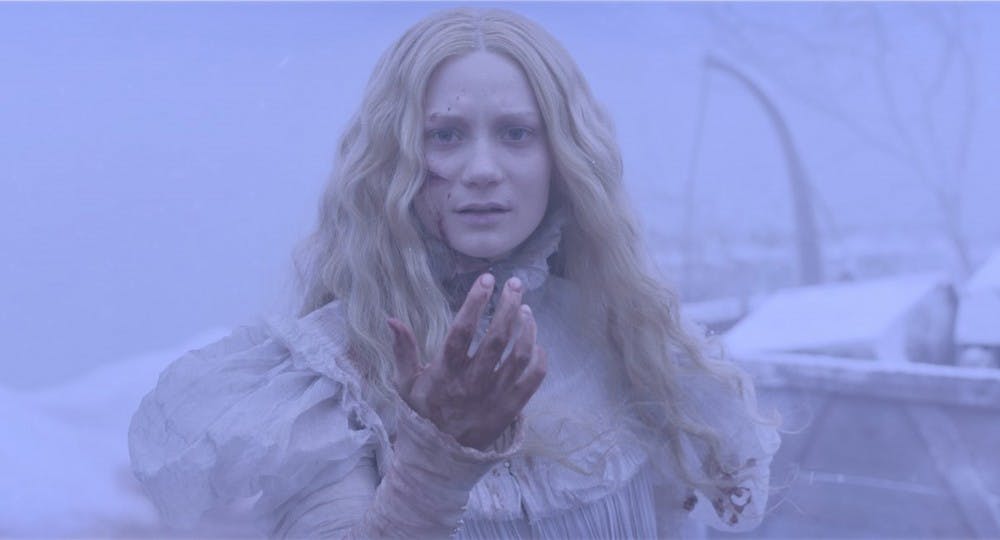At the heart of the Crimson Peak mansion is a gaping hole in the ceiling. Leaves and snow drift precariously through the hole, past the winding staircase and land into a heap on a sinking wooden floor. What perfect symbolism to describe the missing parts of the film “Crimson Peak.”
Edith Cushing — played by Mia Wasikowska — a young woman who resembles a Jane Austen character but strives to become the next Mary Shelley, is no novice to loss. The film begins and ends with Edith’s haunting words, “Ghosts are real, that much I know. I’ve seen them all my life.” After losing her mother to the fatal “black collar” illness, Edith receives a future warning from the ghost of her departed matriarch when she is a child. “Beware Crimson Peak,” the phantom moans. If only the audience had taken this advice.
Aside from the mother ghost, we’re convinced for a good 20 minutes of the film that we’re watching a romance. Edith meets the suave and proper Thomas Sharpe, played by Tom Hiddleston, when he comes to America during the boom of its Industrial Revolution with the hopes of gaining funds for his invention — a machine that unearths the red clay from his estate to make bricks. Sharpe charms Edith, but he has little luck with her father, an industrialist who scoffs at Sharpe’s ideas and his advances toward his daughter.
But an overbearing father isn’t the only harboring factor on this budding romance. Thomas’ stoic sister Lucille, played by Jessica Chastain, seems less than pleased about the new pair now that she has to share the only family she has.
After a suspicious tragedy strikes for Edith once more, she’s whisked away by the Sharpes to their crumbling home at Allerdale Hall, better known to the locals as Crimson Peak.
In many ways, “Crimson Peak” is nothing the audience expects, but everything we expect.
Director Guillermo del Toro mentioned several times in interviews that this movie was a Gothic romance rather than a typical horror movie. Essentially, it’s a rehashed theme from his works “Pan’s Labyrinth” and “The Devil’s Backbone.”
If you scare easily, this movie is surely to make you jump more than once. Yet the horror an audience anticipates from “Crimson Peak” is non-existent. Yes, there are ghosts, hauntings, murder, stabbings and an ungodly amount of blood. But the true horror lies within the constant element of all Gothic romances: love.
In this film we see sides of true love, childhood love, toxic love, wrong love, love for mystery and love for invention.
But we learn even more about longing. We feel it in the characters’ breathy dialogues, from del Toro’s direction and the film itself. And we long for “Crimson Peak” to be better than it is.
The turning point of the film is so predictable anyone with eyes and a semi-functioning attention span can guess what comes next. Where are the twists, the turns? Give us death before you give us weak storylines.
But where the plot thins, Wasikowska picks up the slack with her character. Edith resembles everything we want from a Gothic heroine: hopes, dreams and an obsession with ghosts. Her devotion to her writing and her attempts to even mask her gender from publishing companies in order to make her way as a writer are fresh ideas to the simplistic female protagonist. And for once, a female character isn’t punished in a horror movie after losing her virginity. Edith is a fool in love, but she has the brains to untangle herself from the spider’s web.
Lady Sharpe, on the other hand, is a grave disappointment. Lucille remains trapped, not only in the vicious cycle of Crimson Peak but also in the tragic fate of a two-dimensional character. Her coldness isn’t the hallmark of a woman of means and her madness isn’t a flaw the audience can learn to see past — these are the only two aspects of her personality. Our female antagonist develops not out of abuse and neglect as her backstory tells us but from bad writing and sheer laziness. Most likely, Lucille’s shell of a character will be long forgotten, like a phantom that haunts Crimson Peak.
And if there’s one actor that truly shines in this dismal tale, it’s Hiddleston. It’s no surprise Hiddleston is familiar with Gothic elements and tragic plots. His portrayal of Thomas as the ruinous man caught between the past and the present is a classic we can’t get enough of. We all ache for Thomas — in our hearts and other unmentionable regions. His pleading for success as a man of hard work rather than birthright and his longing looks at Edith brings hope in our eyes and flutters in our chests.
Yet two great characters are not enough to support the weight of an entire film. If there’s anything that needs to be brought back to life, it’s this plot.
Yes, del Toro’s vision is powerful, the imagery shocking and the wardrobes are enough to fall in love with each character alone.
But like all those lost souls of Crimson Peak, we wanted just a little more.




